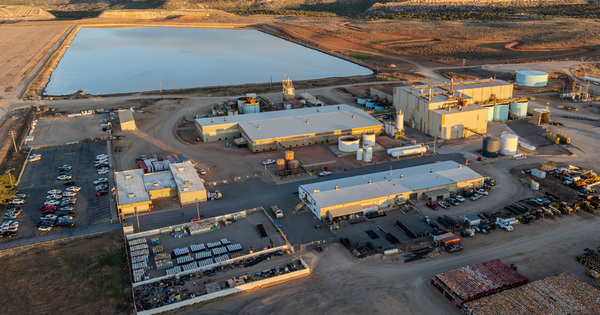Energy Fuels Inc. has successfully produced its first heavy rare earth oxides at the White Mesa Mill in Utah, marking a significant milestone in America’s quest for domestic rare earth element production. The company announced Wednesday that it has separated terbium and dysprosium from monazite ore, making it the first U.S. company to produce these critical heavy rare earth elements at commercial scale in more than two decades.
The achievement represents a crucial step forward in reducing
...
Energy Fuels Inc. has successfully produced its first heavy rare earth oxides at the White Mesa Mill in Utah, marking a significant milestone in America’s quest for domestic rare earth element production. The company announced Wednesday that it has separated terbium and dysprosium from monazite ore, making it the first U.S. company to produce these critical heavy rare earth elements at commercial scale in more than two decades.
The achievement represents a crucial step forward in reducing U.S. dependence on China, which currently dominates global rare earth production and processing. Energy Fuels’ breakthrough comes amid growing concerns about supply chain vulnerabilities in critical minerals essential for clean energy technologies and defense applications.
Mark Chalmers, President and CEO of Energy Fuels, called the development “historic” for both the company and the nation. “Our team has accomplished something that no other company has done in the U.S. for decades,” Chalmers said. “We’ve created a new, responsibly-sourced supply chain for some of the most valuable rare earth elements—ones that are essential for advanced technologies, yet almost exclusively produced in China today.”
The White Mesa Mill, originally built for uranium processing, has been repurposed to handle rare earth elements as part of Energy Fuels’ diversification strategy. The facility began processing monazite sand, a byproduct of heavy mineral sand operations, in 2021. The ore is sourced from Chemours Company’s operations in Georgia.
Heavy rare earth elements like terbium and dysprosium are particularly valuable and strategically important due to their irreplaceable role in permanent magnets used in electric vehicles, wind turbines, and military systems. Dysprosium oxide currently trades at approximately $300 per kilogram, while terbium oxide fetches around $2,500 per kilogram—significantly higher than more common light rare earths.
Industry analysts note that this development addresses a critical gap in the U.S. rare earth supply chain. While several companies have made progress in mining and producing light rare earth elements domestically, the heavy rare earths have remained almost exclusively sourced from China, which controls roughly 70% of global production and nearly 90% of processing capacity.
The company’s rare earth program is part of a broader U.S. strategy to secure domestic supply chains for critical minerals. In recent years, the federal government has provided funding and policy support for rare earth projects through the Department of Energy and Defense Production Act initiatives.
Energy Fuels plans to scale up production and expand its rare earth separation capabilities in the coming months. The company is currently producing mixed rare earth carbonate at the mill, which contains both light and heavy rare earth elements. Most of this product has been shipped to Neo Performance Materials’ facility in Estonia for separation, but Energy Fuels aims to handle more of the separation process domestically.
“This isn’t just about producing rare earths—it’s about creating a complete supply chain that reduces our national vulnerability,” said Chalmers. “We’re working toward a day when we can say that the magnets in American electric vehicles and wind turbines contain materials that were processed right here in the U.S.”
The company’s progress has attracted attention from both government and industry stakeholders. The Department of Energy recently awarded Energy Fuels $18.9 million to help develop commercial rare earth separation capabilities, acknowledging the strategic importance of the project.
Market observers point out that establishing a competitive rare earth industry in the U.S. faces significant challenges, including cost pressures and environmental considerations. China’s dominance in the sector is built on decades of investment, lower production costs, and less stringent environmental regulations.
Environmental groups have historically expressed concerns about the White Mesa Mill, particularly regarding its waste management practices and proximity to tribal lands. Energy Fuels maintains that its operations adhere to strict environmental standards and that rare earth processing actually complements its environmental restoration work at legacy uranium sites.
The company emphasizes that its approach to rare earth production is more environmentally responsible than typical methods used overseas, as it processes already-mined material that would otherwise be considered waste.
As the U.S. continues its push toward electrification and renewable energy, demand for rare earth elements is expected to grow substantially over the next decade. The International Energy Agency projects that the demand for rare earths in clean energy technologies could increase by 700% by 2040 in a scenario aligned with the Paris Agreement climate goals.
Energy Fuels’ breakthrough represents a small but significant step toward rebuilding America’s capacity in this critical sector, though industry experts caution that achieving true supply chain independence will require sustained investment and policy support over many years.


